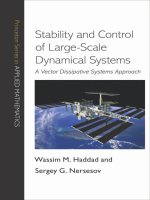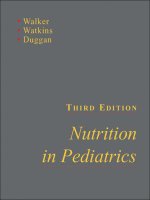TOLLEY’S BASIC SCIENCE AND PRACTICE OF GAS SERVICE Volume 1 pptx
Bạn đang xem bản rút gọn của tài liệu. Xem và tải ngay bản đầy đủ của tài liệu tại đây (10.67 MB, 533 trang )
TOLLEY’S BASIC SCIENCE AND
PRACTICE OF GAS SERVICE
Volume 1
This Page is Intentionally Left Blank
Tolley’s Basic
Science and Practice
of Gas Service
Volume 1
Fourth edition
Edited by
Frank Saxon
Revised by
Route One Training and
Development Limited
AMSTERDAM
•
BOSTON
•
HEIDELBERG
•
LONDON
NEW YORK
•
OXFORD
•
PARIS
•
SAN DIEGO
SAN FRANCISCO
•
SINGAPORE
•
SYDNEY
•
TOKYO
Newnes is an imprint of Elsevier
Newnes is an imprint of Elsevier
Linacre House, Jordan Hill, Oxford OX2 8DP, UK
30 Corporate Drive, Suite 400, Burlington, MA 01803, USA
First edition 1978
Second edition 1990
Third edition 1994
Fourth edition 2006
Copyright © 2006, Elsevier Ltd. All rights reserved
No part of this publication may be reproduced, stored in a retrieval system
or transmitted in any form or by any means electronic, mechanical, photocopying,
recording or otherwise without the prior written permission of the publisher
Permissions may be sought directly from Elsevier’s Science & Technology Rights
Department in Oxford, UK: phone (+44) (0) 1865 843830; fax (+44) (0) 1865 853333;
email: Alternatively you can submit your request online by
visiting the Elsevier web site at and selecting
Obtaining permission to use Elsevier material
Notice
No responsibility is assumed by the publisher for any injury and/or damage to persons
or property as a matter of products liability, negligence or otherwise, or from any use
or operation of any methods, products, instructions or ideas contained in the material
herein. Because of rapid advances in the medical sciences, in particular, independent
verification of diagnoses and drug dosages should be made
British Library Cataloguing in Publication Data
A catalogue record for this book is available from the British Library
Library of Congress Cataloging in Publication Data
A catalogue record for this book is available from the Library of Congress
ISBN-13: 978-0-75-066945-0
ISBN-10: 0-75-066945-4
For information on all Newnes publications visit our website at
Typeset by Integra Software Services Pvt. Ltd, Pondicherry, India
www.integra-india.com
Printed and bound in Great Britain
0607080910 10987654321
Working together to grow
libraries in developing countries
www.elsevier.com | www.bookaid.org | www.sabre.org
Contents
Preface vi
1 Properties of Gases 1
2 Combustion 14
3 Liquefied Petroleum Gas 43
4 Burners 90
5 Energy 122
6 Pressure and Gas Flow 162
7 Control of Pressure 199
8 Measurement of Gas 228
9 Basic Electricity 267
10 Transfer of Heat 323
11 Gas Controls 347
12 Materials and Processes 405
13 Tools 431
14 Measuring Devices 486
Appendix 1 SI Units 511
Appendix 2 Conversion Factors 513
Index 517
v
Preface
Following comprehensive updates and revision of the two other vol-
umes in this series ‘Domestic Gas Installation Practice’ and ‘Indus-
trial and Commercial Gas Installation Practice’ (formerly Gas Service
Technology 2 and 3), it was clearly essential that this, the first volume
in the series, be brought up to date. ‘Basic Science and Practice of
Gas Service’ leads the reader through the knowledge and understand-
ing required to put into practice the safe installation and servicing
procedures described in Volumes 2 and 3.
Changes to standards and legislation have been included, in partic-
ular the European gas directive relating to the prevention of products
of combustion being released into a room in which an open-flued
appliance is installed. Chapter 8 covers the devices used to ensure
that these types of appliances conform to this directive. New types of
combustion analysers and appliance testers which take advantage of
the new technology available have also been included.
There have also been changes to the manner in which gas operatives
are required to prove their competence. It is now a legal require-
ment that all gas operatives in the domestic field and most opera-
tives working in industrial and commercial sectors be registered with
the Confederation of Registered Gas Installers (CORGI). To achieve
membership all operatives must be successful in a series of gas safety
assessments (Nationally Accredited Certification Scheme for Individ-
ual Gas Operatives ACS) in the areas of work in which they operate.
This certification must be renewed every five years.
National Vocational Qualifications are being amended to include
these ACS assessments as part of the qualification process. This vol-
ume and the others in the series will prove invaluable to students
studying for these qualifications and certificates, and for operatives
wishing to improve their knowledge and understanding of natural
gas and Liquefied Petroleum Gas (LPG) systems.
I would like to thank manufacturers for the use of photographs and
diagrams, in particular S.I.T. Gas Controls (ODS devices) and BW
Technologies (flue gas analysers), and also Blackburn College for the
use of their facilities and resources.
Finally, I acknowledge the help received from Michael Webb,
senior editor at Butterworths Tolley and Chris Leggett of typesetters
Letterpart Limited, in putting together this revised update of the third
edition.
vi
CHAPTER 1
Properties of Gases
Chapter 1 is based on an original draft prepared by Mr E.W. Berry
Introduction
This first volume of the manual deals with the elementary science or
‘technology’ which forms the foundation of all gas service work. It
outlines the principles involved and explains how they work in actual
practice.
To do this it has to use scientific terms to describe the principles of
things like ‘force’, ‘pressure’, ‘energy’, ‘heat’ and ‘combustion’. Do
not be put off by these words – they are simply part of the language
of the technology which you have to learn. Every activity from sport
to music has its own special words and gas service is no exception.
While the football fan talks of ‘strikers’, ‘sweepers’ and ‘back fours’
the gas service man deals with ‘calorific values’, ‘standing pressures’
and ‘secondary aeration’.
It is necessary for him to know about these things so that he can be
sure that he has adjusted appliances correctly. He must also know what
actions to take to avoid danger to himself or customers or damage to
customers’ property.
Gas: What It Is
Every substance is made up of tiny particles called ‘molecules’ (see
Chapter 2). In solid substances like wood or metal, there is very little
space between the molecules and they cannot move about (Fig. 1.1).
Fig. 1.1 Molecules in a solid
1
2 BASIC SCIENCE AND PRACTICE OF GAS SERVICE
In liquids, there is a little more space between the particles, so that
a liquid always moves to fit the shape of its container. The molecules
cannot get very far without bumping into each other, however, so they
do not move very quickly and only a few get up enough speed to
break out of the surface and form a vapour above the liquid (Fig. 1.2).
Fig. 1.2 Molecules in a liquid
A gas has a lot more space between its molecules. So they are able to
move about much more freely and quickly. They are continually col-
liding with each other and bouncing on to the sides of their container. It
is this bombardment that creates the ‘pressure’ inside a pipe (Fig. 1.3).
Fig. 1.3 Molecules in a gas
Because the molecules are as likely to move in one direction as in
any other, the pressure on all of the walls of their container will be the
same. Gases must, therefore, be kept in completely sealed containers
otherwise the particles would fly out and mix, or ‘diffuse’, into the
atmosphere (see section on Diffusion).
The word ‘gas’ is derived from a Greek word meaning ‘chaos’.
This is a good name for it, since the particles are indeed in a state of
PROPERTIES OF GASES 3
chaos, whizzing about, colliding and rebounding with a great amount
of energy.
Kinetic Theory
‘Kinetic’ means movement or motion, so kinetic energy is energy
possessed by anything that is moving. A car has kinetic energy when
it is moving along a road. The effect of this can clearly be seen if it
collides with another object! Similarly gas molecules are in motion
and possess kinetic energy at all normal temperatures. The amount of
energy increases as the temperature increases.
The Kinetic Theory states that:
1. The distance between the molecules of a gas is very great
compared with their size (about 400 times as great).
2. The molecules are in continuous motion at all temperatures
above absolute zero, −273
C (see Chapter 5).
3. Although the molecules have an attraction for each other and
tend to hold together, in gases at low pressures the attraction is
negligible compared with their kinetic energy.
4. The amount of energy possessed by the molecules depends on
their temperature and is proportional to the absolute temperature
(see Chapters 5 and 8).
5. The pressure exerted by a gas on the walls of the vessel con-
taining it is due to the perpetual bombardment by the molecules
and is equal at all points.
Diffusion
If a small amount of gas is allowed to leak into the corner of an
average-sized room the smell can be detected in all parts of the room
after a few seconds. This shows that the molecules of gas are in rapid
motion and because of this, gases mix or ‘diffuse’ into each other.
Graham’s Law of Diffusion
If two different gases at the same pressure were put into a container
separated by a wall down the centre and a small hole made in the wall
as shown in Fig. 1.4 then, because the molecules are in continuous
motion, some molecules of each gas would pass through the hole into
the gas on the other side. The faster and lighter molecules would pass
more quickly through the hole into the other gas.
4 BASIC SCIENCE AND PRACTICE OF GAS SERVICE
Fig. 1.4 Diffusion of two gases
After studying the rates at which gases diffuse into each other,
Graham discovered that the rates of diffusion varied inversely as the
square root of the densities of gases. Or:
Diffusion rate ∝
1
√
density
Thus a light gas will diffuse twice as quickly as a gas of four times
its density (see section on Specific Gravity).
The effect can be demonstrated experimentally by filling a porous
pot, made from unglazed porcelain, fitted with a pressure gauge, with
a dense gas such as carbon dioxide. Then place it in another vessel
and fill that with a lighter gas such as hydrogen (see Fig. 1.5). The
pressure inside the inner pot will be seen to rise, proving that the
lighter gas is getting into the pot faster than the heavier gas that is
getting out.
Fig. 1.5 Experiment to demonstrate the effect of diffusion
PROPERTIES OF GASES 5
Chemical Symbols
Symbols are often the initial letters of the name of the substance, like
H for hydrogen, O for oxygen. These symbols are not only a form of
shorthand and save a lot of writing, they also show the amount of the
substance being considered.
Each single symbol indicates one ‘atom’, which is the smallest
chemical particle of the substance (see Chapter 2). So H indicates one
atom of hydrogen, O is one atom of oxygen and so on.
It has previously been said that substances are made up of tiny
particles called ‘molecules’. This is true, but the molecules them-
selves consist of atoms. Sometimes a molecule of a substance contains
only one single atom, like carbon, which is denoted by C. Often
the molecules have more than one atom, like those of hydrogen and
oxygen which both have two atoms. So while an atom is indicated
by H, the smallest physical particle of hydrogen gas which can exist
is shown by H
2
. The ‘2’ in the subscript position indicates that the
molecule of hydrogen is made up of two atoms.
Some substances are made up of combinations of different kinds of
atoms. Water is an example. Water is composed of hydrogen and oxy-
gen and its formation is described in Chapter 2. The chemical formula
for water is H
2
O. This shows that a molecule of water has two atoms
of hydrogen and one of oxygen combined together. Similarly, methane
gas, which forms the main part of natural gas, is made up of one atoms
of carbon and four atoms of hydrogen. So its formula is CH
4
.
Table 1.1 shows the chemical symbols and formulae for some of
the substances met with in gas service work.
TABLE 1.1 Chemical symbols and formulae for substances
commonly used during gas service work
Substance
Chemical
formulae Substance
Chemical
formulae
Gases Metals
Hydrogen H
2
Iron Fe
Oxygen O
2
Copper Cu
Nitrogen N
2
Lead Pb
Carbon monoxide CO Tin Sn
Carbon dioxide CO
2
Zinc Zn
Methane CH
4
Antimony Sb
Ethane C
2
H
6
Platinum Pt
Propane C
3
H
8
Nickel Ni
Butane C
4
H
10
Chromium Cr
Propylene C
3
H
6
Tungsten W
Mercury Hg
6 BASIC SCIENCE AND PRACTICE OF GAS SERVICE
Odour
Gas can, of course, be dangerous. It can burn and it can explode. Some
gases are ‘toxic’ or poisonous. But all fuels are potential killers if not
treated properly. Coke and oil both burn and can produce poisonous
fumes. Electricity causes more domestic fires than any other fuel and
the first indication you get of its presence could be your last!
Gas has the advantage of having a characteristic smell or ‘odour’ so
it is easily recognisable. Several of the combustible gases, including
hydrogen, carbon monoxide and methane, are colourless and odourless
and could not easily be detected without elaborate equipment. To make
it possible for customers to find out when they have a gas escape or
have accidentally turned on a tap and not lit the burner, a smell or
odour, is added to the gas.
Gas manufactured from coal has its own smell, natural gas does not.
But suppliers of natural gas are required to add a smell to it before
sending the gas out to the customers. So an ‘odorant’ is used, origi-
nally a chemical called tetrahydrothiophene. Only a very small amount
is added, something like
1
/2 kg to a million cubic feet of gas. Odorants
now in use contain diethyl sulphide and ethyl and butyl mercaptan.
Toxicity
A number of gases are ‘toxic’ or poisonous and inhaling them can
result in death. Newspaper reports of people being ‘gassed’ are usually
referring to carbon monoxide poisoning.
Carbon monoxide, CO, is the ingredient which causes the problem.
By replacing oxygen in the bloodstream it prevents the blood from
maintaining life and so the organs of the body become poisoned.
CO is one of the constituents of gas made from coal or oil, and
inhaling the unburnt gas can prove fatal. Natural gas does not contain
CO and so it is ‘non-toxic’.
This means, of course, that people can no longer commit suicide by
gassing themselves. There is another hazard, however. All fuels which
contain carbon can produce carbon monoxide in their flue gases if the
carbon is not completely burned. So people can still be gassed if the
appliances are not flued or ventilated correctly (see Chapter 2). There
is always a risk of suffocation if the presence of the gas reduces the
amount of oxygen in the air.
Calorific Value
All gases which burn give off heat (energy) and the ‘calorific value’,
or CV, indicates the heating power. It is the number of heat (energy)
units which can be obtained from a measured volume of the gas.
PROPERTIES OF GASES 7
To measure CV in SI units, megajoules per cubic metre are used,
written as MJ/m
3
. The CV of natural gas in the UK is about
393MJ/m
3
but does vary slightly from district to district. Because
customers pay for the gas they use measured in heat units, British
Gas has to declare the calorific value of its supply and this is printed
on every gas bill. The actual CV is monitored at official testing sta-
tions by gas examiners, appointed by the Department of Trade and
Industry.
Meters presently used by British Gas plc measure gas in cubic
feet 100 ft
3
=283 m
3
and until April 1992 customers were charged,
based on the number of ‘therms’ used 1 therm = 105506 MJ.
EC directive 80/181 required Britain to change their method of
billing from imperial to metric units and British Gas plc implemented
this change from April 1992 using the metric kilowatt hour (kWh) as
a basis for charge. It is the common unit used in Europe and is of
course the basis of charge for electricity.
The total amount of heat obtained from gas is, in fact, the Gross CV.
If however,the watervapour inthe productsof combustionis notallowed
to condense into water, the amount of heat obtained is the Net CV.
Specific Gravity (Relative Density)
Every substance has weight or ‘mass’, including gas. Some compli-
cated scientific equipment would be needed to do the weighing, but
it can be weighed. It is necessary, for various reasons, to compare
weights of gases and to do this a comparison is made of their ‘den-
sities’. The density of a substance is the weight of a given volume.
In Imperial units it is the number of pounds per cubic foot lb/ft
3
,
and in SI units it is the number of kilogrammes per cubic metre
kg/m
3
.
Densities of substances vary very considerably. Lead is heavier than
wood and wood is lighter than water. In order to compare densities
they are related to a standard substance. For solids and liquids the
standard is water. For gases the standard is air.
This relationship between the density of a substance and the density
of the standard is known as the ‘relative density’ or ‘specific gravity’.
Let us take the example of mercury. The specific gravity (or SG) of
liquid mercury is 13.57. So it is about 13
1
/2 times as heavy as the
same bulk of water, or 1 litre would weigh 13.57 kg.
The specific gravity of natural gas is in the region of 0.5. So it is
about half the weight of the same volume of air. The specific gravity
of LPG is greater than that of air.
8 BASIC SCIENCE AND PRACTICE OF GAS SERVICE
Wobbe Number
The Wobbe number of Wobbe ‘index’ gives an indication of the heat
output from a burner when using a particular gas (the terms Wobbe
number and Wobbe index are used interchangeably in this book.)
The amount of heat which a burner will give depends on the fol-
lowing factors:
1. The amount of heat in the gas as given by its calorific value.
2. The rate at which the gas is being burned. This rate depends on
the following.
2.1 The size of the ‘jet’ or ‘injector’.
2.2 The pressure in the gas, pushing it out of the injector.
2.3 The relative weight of the gas. This affects how easily the
pressure can push it out and is indicated by the specific
gravity.
Looking at these factors it can be seen that they divide up into two
groups.
1. Factors depending on the gas
– calorific value (1)
– specific gravity (2.3).
2. Factors depending on the appliance
– size of injector (2.1)
– pressure of the gas (2.2).
Since the factors in group 2 are fixed by the design or the adjustment
of the appliance, the only alterations in heat output would be brought
about by changes in the group 1 factors. That is, changes in the
characteristics of the gas, the CV and the SG. The Wobbe number
links these two characteristics and is obtained by dividing the CV by
the square root of the SG, thus:
Wobbe number =
CV
√
SG
It is essential to ensure that the heat outputs of appliances are kept
reasonably constant. To do this the Wobbe number of the gas must be
maintained within fairly close limits.
Natural gas with a CV of 3933 MJ/m
3
and a SG of 0.58 would
have a Wobbe number of 51.64.
PROPERTIES OF GASES 9
Families of Gases
To ensure that appliances operate correctly the gas quality must be
maintained within close limits. In practice, it is kept to a quality range
indicated by Wobbe numbers.
There are three ranges or ‘families’ which have been agreed inter-
nationally (Table 1.2). Family 1 covers manufactured gases, fam-
ily 2 covers natural gases and family 3 covers liquefied petroleum
gas (LPG).
TABLE 1.2 Families of gases
Family Approximate Wobbe number range Type of gas
1 22.5–30 Manufactured
(inc. LPG/air)
2
L
H
39.1–45
Natural
45.5–55
3 73.5–87.5 LPG
Appliances are designed to operate on gas of a particular family.
Manufactured gases are generally made from coal, oil feed-stocks
or naphthas and also include LPG/air mixtures.
Natural gases come from well-heads in the North Sea, Morecambe
Bay and can be imported from other countries.
Liquefied petroleum gases include propane, butane and mixtures.
They will be dealt with in more detail in Chapter 3.
Air Requirements
Everything that burns must have oxygen in order to do so. Fuel gases
contain carbon and hydrogen compounds which burn when they are
lit and allowed to combine with oxygen (see Chapter 2).
Fortunately the atmosphere consists of about 21% oxygen and 79%
nitrogen (with a tiny amount of other gases). This means that if a gas
flame is allowed to burn freely in the open, it can get the oxygen it
needs from the surrounding air.
For each cubic metre m
3
of gas burned, the amount of air
required is:
•
489 m
3
for butane/air
•
975 m
3
for natural gas
•
238m
3
for commercial propane.
10 BASIC SCIENCE AND PRACTICE OF GAS SERVICE
Aeration
Gas can be burned straight out of a jet, getting the air it requires
from the atmosphere around the flame. This happens with a ‘neat’ or
‘non-aerated’ burner.
For a number of uses a different kind of flame is necessary and to
get this a proportion of the air is allowed to mix with the gas before
it is burned. This happens in the ‘aerated burner’ and the air added
first is called ‘primary air’, as distinct from ‘secondary air’ which is
the remaining air required and obtained from around the flame.
The proportion of air mixed before ‘combustion’ or burning is called
the ‘primary aeration’. It is usually expressed as a percentage. For
example a burner with 50% primary aeration would have half the total
air requirement mixed with the gas before it was burned.
Gas Modulus
The ‘gas modulus’ is a numerical expression which relates the heat
output from a burner with the pressure required to provide a satisfac-
tory amount of aeration. It gives a figure which indicates how aeration
and heat loading conditions may be maintained when changing from
one gas to another.
The modulus is obtained by dividing the square root of the pressure
by the Wobbe index. Thus:
Gas modulus =
√
pressure
Wobbe index
Using the modulus shows that to change from a manufactured gas
with a Wobbe index of 27.2 supplied at a pressure of 6.23 mbar to a
natural gas with a Wobbe index of 49.6 required the pressure to be
increased to 20.62 mbar to maintain the same operating conditions (see
Chapter 4, section on Modifying Appliances to Burn Other Gases).
Flammability Limits
Mixtures of gas and air will burn, but only within limits. If there is
either too much gas or too much air, the mixture will not burn. The
‘flammability limits’ are those air and gas mixtures at each end of the
range which will just burn. For natural gas the range is from 5% up
to 15% of gas in the mixture. So the limits are 5% gas for the lower
explosive limit (LEL) and 15% gas for the higher explosive limit
PROPERTIES OF GASES 11
(HEL). For commercial propane the limits are 2.0–10.0% and for
butane/air the limits are narrower being from 1.6 to 7.75% gas.
Flame Speed
All flames burn at particular rates. You can watch a flame burning its
way along a match or taper. Similarly a gas flame is burning along
the mixture as it comes out of the jet or burner at a particular speed.
The speed at which the mixture is coming out has to be adjusted so
that the flame will stay on the tip of the burner. If it came out too fast
it would blow the flame off and if it was too slow the flame could
burn its way back inside the tube!
The flame speed of gas is measured in metres per second. Typical
flame speeds are:
•
natural gas 0.36 m/s
•
butane/air 0.38 m/s
•
commercial propane 0.46 m/s.
Ignition Temperatures
Gases need to be lit or ‘ignited’ before they will burn. This is done
by heating the gas until it reaches a sufficiently high temperature to
burst into flame and keep burning.
Heating the gas to the required temperature may be done with a
match, a small gas flame or ‘pilot’, an electric spark, or a coil of wire
or ‘filament’ made red hot by an electric current. Ignition temperatures
of the common gases are:
•
natural gas 704
C
•
butane/air 500
C
•
commercial propane 530
C.
TABLE 1.3 Constituents of gases
Constituent Formulae Typical percentage by volume
Natural gas Comm. propane Butane/air
Oxygen O
2
1701
Nitrogen N
2
276399
Carbon dioxide CO
2
06
Methane CH
4
900
Ethane C
2
H
6
5315
Propylene C
3
H
6
120
Propane C
3
H
8
1085925
Butane C
4
H
10
0406165
100 100 100
12 BASIC SCIENCE AND PRACTICE OF GAS SERVICE
Substitute Natural Gas
Substitute natural gas (SNG) is manufactured either as a direct substi-
tute for natural gas or as a means of providing additional gas to meet
peak loads. It can be made from a range of feed-stocks in a number
of different types of plant. The feed-stocks commonly used are LPG
or naphthas, which are light petroleum distillates. The feed-stock is
mixed with high pressure steam and passed over a catalyst to produce
a Catalytic Rich Gas (CRG). After this it may pass through additional
processes to increase its percentage of methane and to remove carbon
dioxide. An example of an SNG plant is shown in Fig. 1.6.
For combustion to be useable, it must be controlled; uncontrolled it
will be dangerous and inefficient. To control combustion and achieve
fuel efficiency, and complete combustion process, it is necessary
to understand the characteristics of the fuel and the way it burns.
Table 1.4 below provides the comparison of properties of typical
gases.
TABLE 1.4 Comparison of properties of typical gases
Property Units
Natural
gas
Commercial
Propane Butane/Air
Calorific value MJ/m
3
39.3 97.3 23.75
Specific gravity air = 1 0.58 1.5 1.19
Wobbe number MJ/m
3
51.64 79.4 21.79
Air required vol/vol 9.75 23.8 4.89
Flammability limits % gas in air 5–15 2–10 1.6–7.75
Flame speed m/s 0.36 0.46 0.38
Ignition temperature
C 704 530 500
The characteristics of SNG from the ‘double methanation process’
are shown in Table 1.5. The gas produced is a non-toxic, high-methane,
low-inert gas interchangeable with natural gas, and it can be supplied
directly into pipelines.
TABLE 1.5 Characteristics of typical SNG
Constituent Formulae Percentage by volume
Methane CH
4
985
Hydrogen H
2
09
Carbon monoxide CO 01
Calorific value 38 MJ/m
3
Specific gravity 0.555 air = 10
Wobbe number 51 MJ/m
3
PROPERTIES OF GASES 13
Fig. 1.6 Substitute natural gas (SNG) plant. A catalytic rich gas producer with a double methanation process
CHAPTER 2
Combustion
Chapter 2 is based on an original draft prepared by Mr E.W. Berry
Combustion
Fuel gases burn when they are ignited and allowed to combine with oxy-
gen, usually taken from the air. This burning or ‘combustion’ is in fact
a chemical reaction taking place, a reaction which produces heat and
changes the gas and air into other gases. In order to understand what
exactly is taking place and what new substances are being produced by
the combustion, it is necessary to study a little very simple chemistry.
Start by looking at atoms and molecules in a little more detail.
Atoms
The atom was introduced in Chapter 1 as the smallest chemical particle
into which a substance may be divided by chemical means. Atoms are,
however, made up of three components. There are over 100 different
kinds of atoms each containing different numbers of the three basic
components.
All atoms consist of a relatively heavy central core or ‘nucleus’ with
very light ‘electrons’ revolving or orbiting round it at a little distance.
The nucleus has a positive (or +) electrical charge and the elec-
trons have negative (or −) electrical charges. The positively charged
particles in the nucleus are called ‘protons’. Usually the number of
electrons and protons in an atom are the same so that the negative and
positive charges balance out and the atom is electrically neutral. The
simplest of all atoms is the common hydrogen atom (Fig. 2.1). It has
a single proton round which revolves a single electron.
Some atoms have additional particles in the nucleus which are
similar to protons but are electrically neutral (i.e. without charge).
These particles are called ‘neutrons’. A few hydrogen atoms have
neutrons as well as protons, and the nucleus of ‘heavy hydrogen’ is
thought to have one proton and one neutron (Fig. 2.2).
14
COMBUSTION 15
Fig. 2.1 Structure of the hydrogen atom
Fig. 2.2 Structure of the deuterium (or ‘heavy hydrogen’) atom
The weight or mass of an atom depends on the number of protons
and neutrons in the nucleus. The electrons are so tiny, by comparison,
that they do not affect the overall mass of the atom. So the three
components of an atom are:
1. electrons
2. protons
3. neutrons.
Electrons move around the nucleus of an atom in fixed orbits. There
can be up to seven orbits of electrons in the more complex atoms. The
inner orbit or ‘shell’ can contain up to two electrons. The next holds
up to eight electrons. Each shell holds a fixed number of electrons.
The chemical behaviour of an atom depends largely on the number
of electrons in its outer shell. This particularly affects the ability of
the atom to combine with others to form molecules. Stable substances
are those whose outer shell contains its full complement of electrons.
Other substances, with outer shells which are not completely full, are
less stable and so combine more readily together to form more stable
substances. Carbon, for example, has two electron shells. With two
electrons in its inner shell, but only four in its outer shell, it combines
readily with other substances.
Molecules
A molecule is the smallest particle of a substance which can exist
independently and still retain the properties of that substance.
16 BASIC SCIENCE AND PRACTICE OF GAS SERVICE
A molecule of methane, CH
4
, consists of one atom of carbon and
four atoms of hydrogen (Fig. 2.3). You can see that, by sharing elec-
trons with the hydrogen atoms, the carbon atom can fill up its outer
shell to the full eight electrons and so form a stable substance.
Fig. 2.3 Structure of a molecule of methane
Elements
An element is a substance whose molecules contain only one kind of
atom. Examples of elements are hydrogen, H
2
, oxygen, O
2
, nitrogen,
N
2
, iron, Fe, copper, Cu.
Compounds
Compounds are substances whose molecules contain more than one
kind of atom. For example, water, H
2
O, contains the atoms of hydro-
gen and oxygen. Similarly methane, CH
4
, is a compound since it
contains both carbon and hydrogen atoms.
Mixtures and Compounds
It is possible for substances to be brought together either as compounds
or as mixtures and there are important differences between the two.
Table 2.1 shows the main differences.
As an example, suppose that iron filings and sulphur were stirred
together in any proportions. The result would be a grey powder which
would be slightly magnetic. This would be a mixture.
It would be possible to separate the components of this particular
mixture by removing the iron filings with a magnet or by dissolving
the sulphur in carbon disulphide.
COMBUSTION 17
TABLE 2.1 Differences between mixtures and compounds
Compounds Mixtures
There are fixed proportions of constituents May have variable proportions
Produced by a chemical reaction usually
associated with heat
Made by adding constituents together in some
container
Cannot be separated by physical means Can be separated by physical means
Has properties often very different from
those of its constituents
Has properties related directly to its constituents,
each contributing its own particular property
to the whole
Now suppose that a mixture of iron filings and sulphur was heated. It
would become red hot as if burning and, when it cooled, a black brittle
solid would be found which was not magnetic or soluble in carbon disul-
phide. This would be ferrous sulphide, FeS, in which each atom of iron
had combined with an atom of sulphur. This would be a compound.
It would not be possible to remove either the iron or the sulphur
from the ferrous sulphide.
Combustion Equations
Chemical reactions may be written in the form of equations. Take, for
example, the combustion of methane.
Methane, CH
4
, burns in combination with oxygen, O
2
, in the air.
In doing so it produces carbon dioxide, CO
2
, and water vapour, H
2
O
(see Fig. 2.4). Written as an equation this becomes:
CH
4
+2O
2
= CO
2
+2H
2
O
Fig. 2.4 Combustion of methane
18 BASIC SCIENCE AND PRACTICE OF GAS SERVICE
Notice that, as with all equations, both sides balance.
•
There is one carbon atom on each side.
•
There are four hydrogen atoms on each side.
•
There are four oxygen atoms on each side.
•
Altogether there are nine atoms on each side.
Since there is a direct relationship between the number of molecules
and the volume of gases, the equation shows the volumes of gases
involved. So,
CH
4
+ 2O
2
= CO
2
+ 2H
2
O
1 volume requires 2 volumes and 1 volume and 2 volumes
methane oxygen gives carbon water
off dioxide vapour
This is true for any volume of methane. Figure 2.5 shows the
theoretical volumes involved when one cubic metre of methane is
burned in an appliance.
Fig. 2.5 The volumes of gases involved in the combustion of methane
Both natural gas and LPG are mixtures of gases and their con-
stituents are given in Table 1.3. The chemical equations for their
combustion are as follows.
•
Natural gas
Nitrogen: This is not flammable and takes no part in combus-
tion, Hence it is called ‘inert’.
Carbon dioxide: This is not flammable. It is actually a product
of combustion.









